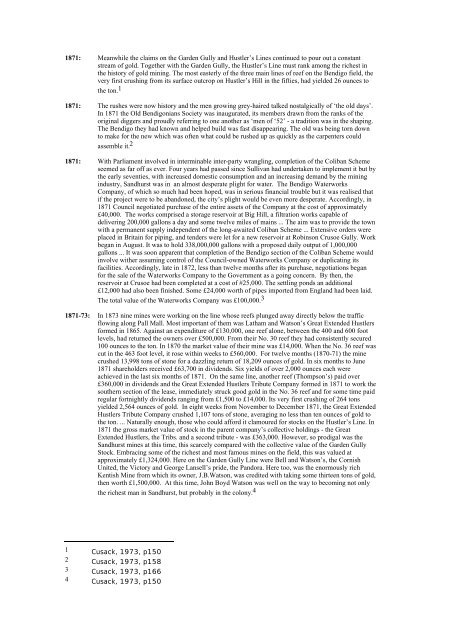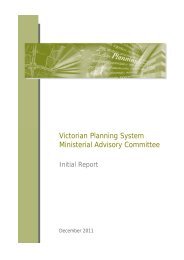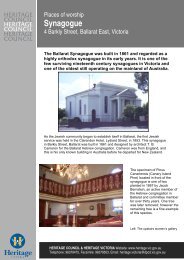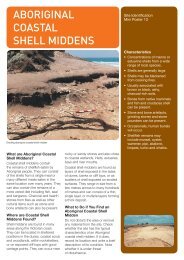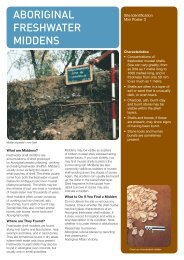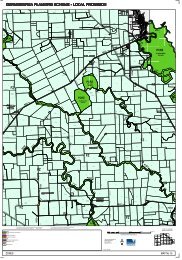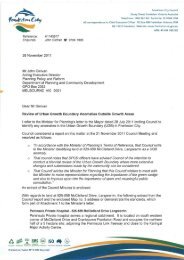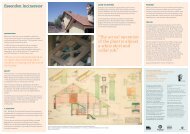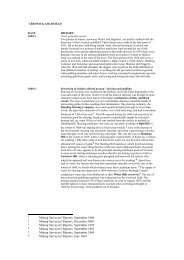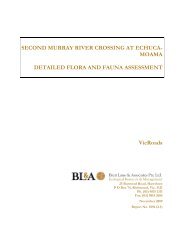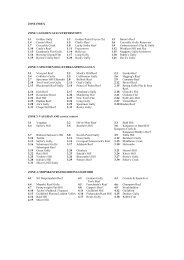Bendigo General History - Department of Planning and Community ...
Bendigo General History - Department of Planning and Community ...
Bendigo General History - Department of Planning and Community ...
You also want an ePaper? Increase the reach of your titles
YUMPU automatically turns print PDFs into web optimized ePapers that Google loves.
1871: Meanwhile the claims on the Garden Gully <strong>and</strong> Hustler’s Lines continued to pour out a constant<br />
stream <strong>of</strong> gold. Together with the Garden Gully, the Hustler’s Line must rank among the richest in<br />
the history <strong>of</strong> gold mining. The most easterly <strong>of</strong> the three main lines <strong>of</strong> reef on the <strong>Bendigo</strong> field, the<br />
very first crushing from its surface outcrop on Hustler’s Hill in the fifties, had yielded 26 ounces to<br />
the ton. 1<br />
1871: The rushes were now history <strong>and</strong> the men growing grey-haired talked nostalgically <strong>of</strong> ‘the old days’.<br />
In 1871 the Old <strong>Bendigo</strong>nians Society was inaugurated, its members drawn from the ranks <strong>of</strong> the<br />
original diggers <strong>and</strong> proudly referring to one another as ‘men <strong>of</strong> ‘52’ - a tradition was in the shaping.<br />
The <strong>Bendigo</strong> they had known <strong>and</strong> helped build was fast disappearing. The old was being torn down<br />
to make for the new which was <strong>of</strong>ten what could be rushed up as quickly as the carpenters could<br />
assemble it. 2<br />
1871: With Parliament involved in interminable inter-party wrangling, completion <strong>of</strong> the Coliban Scheme<br />
seemed as far <strong>of</strong>f as ever. Four years had passed since Sullivan had undertaken to implement it but by<br />
the early seventies, with increased domestic consumption <strong>and</strong> an increasing dem<strong>and</strong> by the mining<br />
industry, S<strong>and</strong>hurst was in an almost desperate plight for water. The <strong>Bendigo</strong> Waterworks<br />
Company, <strong>of</strong> which so much had been hoped, was in serious financial trouble but it was realised that<br />
if the project were to be ab<strong>and</strong>oned, the city’s plight would be even more desperate. Accordingly, in<br />
1871 Council negotiated purchase <strong>of</strong> the entire assets <strong>of</strong> the Company at the cost <strong>of</strong> approximately<br />
£40,000. The works comprised a storage reservoir at Big Hill, a filtration works capable <strong>of</strong><br />
delivering 200,000 gallons a day <strong>and</strong> some twelve miles <strong>of</strong> mains ... The aim was to provide the town<br />
with a permanent supply independent <strong>of</strong> the long-awaited Coliban Scheme ... Extensive orders were<br />
placed in Britain for piping, <strong>and</strong> tenders were let for a new reservoir at Robinson Crusoe Gully. Work<br />
began in August. It was to hold 338,000,000 gallons with a proposed daily output <strong>of</strong> 1,000,000<br />
gallons ... It was soon apparent that completion <strong>of</strong> the <strong>Bendigo</strong> section <strong>of</strong> the Coliban Scheme would<br />
involve wither assuming control <strong>of</strong> the Council-owned Waterworks Company or duplicating its<br />
facilities. Accordingly, late in 1872, less than twelve months after its purchase, negotiations began<br />
for the sale <strong>of</strong> the Waterworks Company to the Government as a going concern. By then, the<br />
reservoir at Crusoe had been completed at a cost <strong>of</strong> #25,000. The settling ponds an additional<br />
£12,000 had also been finished. Some £24,000 worth <strong>of</strong> pipes imported from Engl<strong>and</strong> had been laid.<br />
The total value <strong>of</strong> the Waterworks Company was £100,000. 3<br />
1871-73: In 1873 nine mines were working on the line whose reefs plunged away directly below the traffic<br />
flowing along Pall Mall. Most important <strong>of</strong> them was Latham <strong>and</strong> Watson’s Great Extended Hustlers<br />
formed in 1865. Against an expenditure <strong>of</strong> £130,000, one reef alone, between the 400 <strong>and</strong> 600 foot<br />
levels, had returned the owners over £500,000. From their No. 30 reef they had consistently secured<br />
100 ounces to the ton. In 1870 the market value <strong>of</strong> their mine was £14,000. When the No. 36 reef was<br />
cut in the 463 foot level, it rose within weeks to £560,000. For twelve months (1870-71) the mine<br />
crushed 13,998 tons <strong>of</strong> stone for a dazzling return <strong>of</strong> 18,209 ounces <strong>of</strong> gold. In six months to June<br />
1871 shareholders received £63,700 in dividends. Six yields <strong>of</strong> over 2,000 ounces each were<br />
achieved in the last six months <strong>of</strong> 1871. On the same line, another reef (Thompson’s) paid over<br />
£360,000 in dividends <strong>and</strong> the Great Extended Hustlers Tribute Company formed in 1871 to work the<br />
southern section <strong>of</strong> the lease, immediately struck good gold in the No. 36 reef <strong>and</strong> for some time paid<br />
regular fortnightly dividends ranging from £1,500 to £14,000. Its very first crushing <strong>of</strong> 264 tons<br />
yielded 2,564 ounces <strong>of</strong> gold. In eight weeks from November to December 1871, the Great Extended<br />
Hustlers Tribute Company crushed 1,107 tons <strong>of</strong> stone, averaging no less than ten ounces <strong>of</strong> gold to<br />
the ton. ... Naturally enough, those who could afford it clamoured for stocks on the Hustler’s Line. In<br />
1871 the gross market value <strong>of</strong> stock in the parent company’s collective holdings - the Great<br />
Extended Hustlers, the Tribs. <strong>and</strong> a second tribute - was £363,000. However, so prodigal was the<br />
S<strong>and</strong>hurst mines at this time, this scarcely compared with the collective value <strong>of</strong> the Garden Gully<br />
Stock. Embracing some <strong>of</strong> the richest <strong>and</strong> most famous mines on the field, this was valued at<br />
approximately £1,324,000. Here on the Garden Gully Line were Bell <strong>and</strong> Watson’s, the Cornish<br />
United, the Victory <strong>and</strong> George Lansell’s pride, the P<strong>and</strong>ora. Here too, was the enormously rich<br />
Kentish Mine from which its owner, J.B.Watson, was credited with taking some thirteen tons <strong>of</strong> gold,<br />
then worth £1,500,000. At this time, John Boyd Watson was well on the way to becoming not only<br />
the richest man in S<strong>and</strong>hurst, but probably in the colony. 4<br />
1 Cusack, 1973, p150<br />
2 Cusack, 1973, p158<br />
3 Cusack, 1973, p166<br />
4 Cusack, 1973, p150


